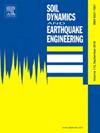The influence of SICP treatment composition on the performance of liquefaction resistance of soils
IF 4.2
2区 工程技术
Q1 ENGINEERING, GEOLOGICAL
引用次数: 0
Abstract
Soybean urease-induced calcium carbonate precipitation (SICP) is an innovative and eco-friendly approach with demonstrated potential for mitigating soil liquefaction. However, the specific impacts of the concentrations of soybean urease and salt solutions require further elucidation. The research examines how the two compositions influence calcium carbonate formation. Dynamic characteristics of one-cycle SICP-treated clean and silty sand were analyzed based on cyclic triaxial tests. It was revealed that SICP-treated specimens of both liquefied sand and silty sand exhibit reduced accumulation of excess pore pressure and diminished strain growth under cyclic loading, thereby delaying liquefaction failure. Although higher concentrations of both soybean urease and salt solution can enhance liquefaction resistance, salt solution concentration has a more pronounced effect on improving liquefaction resistance due to the more production of calcium carbonate. Scanning electron microscopy observations confirmed the presence of calcium carbonate crystals at the interfaces between sand particles and between sand and fine particles. These crystals effectively bond the loose sand and fine particles into a cohesive matrix, reinforcing soil structure. A direct linear correlation was established between the liquefaction resistance improvement and precipitated calcium carbonate content. Notably, the one-cycle SICP treatment method adopted in this study demonstrates a better biocementation effect compared to cement mortar or multi-cycle MICP-treated sand under the same content of cementitious materials. These findings provide valuable insights for optimizing SICP treatments, aiming to reduce the risk of soil liquefaction in potential field applications.
SICP处理组分对土壤抗液化性能的影响
大豆脲酶诱导碳酸钙沉淀(SICP)是一种创新和环保的方法,具有减轻土壤液化的潜力。然而,大豆脲酶浓度和盐溶液的具体影响需要进一步阐明。研究考察了这两种成分如何影响碳酸钙的形成。在循环三轴试验的基础上,分析了单周期sicp处理净砂和粉砂的动态特性。结果表明,sicp处理的液化砂和粉砂试样在循环荷载作用下均表现出超孔隙压力积累减少和应变增长减弱,从而延缓了液化破坏。虽然较高浓度的大豆脲酶和盐溶液都能增强抗液化能力,但由于碳酸钙产量增加,盐溶液浓度对提高抗液化能力的作用更为明显。扫描电镜观察证实,在砂粒之间和砂粒与细粒之间的界面存在碳酸钙晶体。这些晶体有效地将松散的沙子和细颗粒结合成一个有凝聚力的基质,加强土壤结构。抗液化性能的提高与沉淀碳酸钙含量之间存在直接的线性关系。值得注意的是,在相同胶凝材料含量下,本研究采用的单循环SICP处理方法比水泥砂浆或多循环micp处理砂具有更好的生物胶结效果。这些发现为优化SICP处理提供了有价值的见解,旨在降低潜在现场应用中土壤液化的风险。
本文章由计算机程序翻译,如有差异,请以英文原文为准。
求助全文
约1分钟内获得全文
求助全文
来源期刊

Soil Dynamics and Earthquake Engineering
工程技术-地球科学综合
CiteScore
7.50
自引率
15.00%
发文量
446
审稿时长
8 months
期刊介绍:
The journal aims to encourage and enhance the role of mechanics and other disciplines as they relate to earthquake engineering by providing opportunities for the publication of the work of applied mathematicians, engineers and other applied scientists involved in solving problems closely related to the field of earthquake engineering and geotechnical earthquake engineering.
Emphasis is placed on new concepts and techniques, but case histories will also be published if they enhance the presentation and understanding of new technical concepts.
 求助内容:
求助内容: 应助结果提醒方式:
应助结果提醒方式:


